May 22, 2025 | 09:50 GMT +7
May 22, 2025 | 09:50 GMT +7
Hotline: 0913.378.918
May 22, 2025 | 09:50 GMT +7
Hotline: 0913.378.918
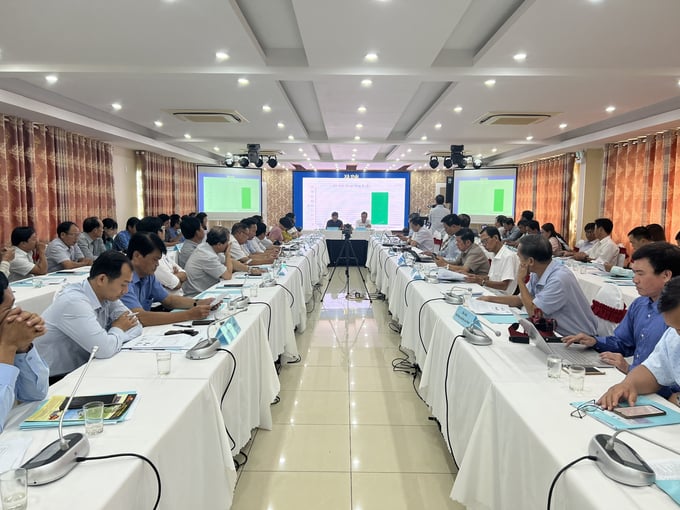
The conference on the development of a low-emission and sustainable shrimp industry in Vietnam is jointly organized by the Ministry of Agriculture and Rural Development and the United Nations Development Programme (UNDP). Photo: Trong Linh.
The conference on the development of a low-emission and sustainable shrimp industry in Vietnam was jointly organized by the Ministry of Agriculture and Rural Development and the United Nations Development Programme (UNDP) on October 26, in Bac Lieu city, Bac Lieu province. Accordingly, the event was organized as part of the project "Promoting Private Sector Investment in Low-Carbon and Climate-Resilient Agriculture to Contribute to Vietnam's Nationally determined contribution or NDC."
Mr. Nguyen Trung Hieu, Deputy Director of the Bac Lieu province's Department of Agriculture and Rural Development, stated that Bac Lieu is one of the three key exporting province in Vietnam. The province has made considerable efforts to implement various programs, projects, initiatives, and activities to support the shrimp farming industry and boost shrimp exports. Namely, the Provincial People's Committee issued Decision No. 215/QD-UBND on July 28, 2020, approving the "Building Bac Lieu as the National Shrimp Industry Center" project.
The project identifies Bac Lieu as a focal province and a hub for connecting provinces in the development of brackish water shrimp farming in the Mekong Delta region. It aims to achieve a total shrimp farming area in the province of approximately 156,000 hectares by 2025, including 40,000 hectares of intensive, semi-intensive, and high-tech shrimp farming models.
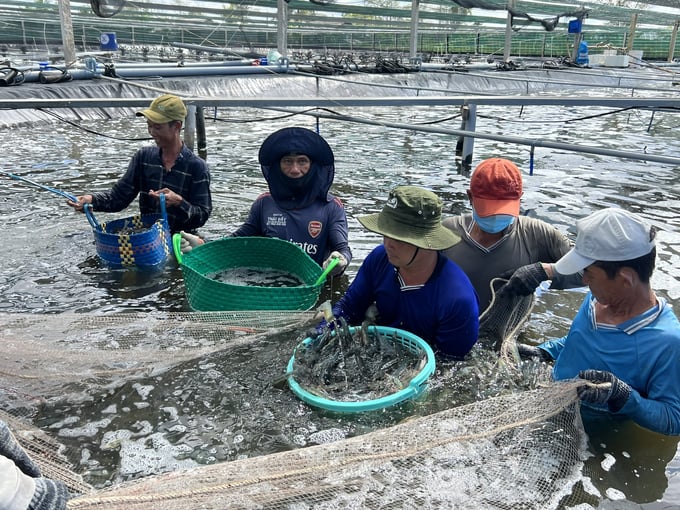
High-tech shrimp farming with water circulation model in Bac Lieu province. Photo: Trong Linh.
Mr. Nguyen Do Anh Tuan, Head of the International Cooperation Department under the Ministry of Agriculture and Rural Development, stated that Vietnam's seafood industry has achieved positive results. Namely, it maintained a stable growth rate at between 4% and 5% for several years, which accounts for 28.7% of the total value of the entire agricultural sector. Vietnam's total seafood production in the first nine months of 2023 reached nearly 6.8 million tons, including nearly 3.8 million tons from aquacultural production. By the end of September 2023, the total seafood export turnover reached 6.67 billion USD. Furthermore, the industry plays a crucial role in social stability, and safeguarding the country's security and sovereignty over seas and islands.
However, the seafood industry is currently facing numerous challenges, including escalating raw material prices, volatile markets, and intense international competition, especially under the influence of climate change. On the other hand, many small-scale households still struggle with limited production scale, and the infrastructure for water supply, electricity, and transportation in a number of aquaculture areas lacks sufficient investment. Varied levels of awareness and knowledge among the population also stand as obstacles to accessing science and technology.
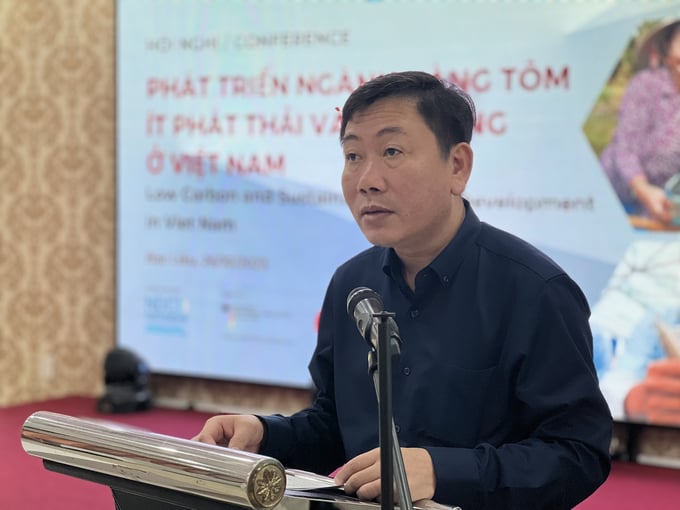
Mr. Nguyen Do Anh Tuan, Head of the International Cooperation Department under the Ministry of Agriculture and Rural Development, giving a speech at the conference. Photo: Trong Linh.
"It is time for Vietnam to develop its food system as well as the shrimp value chain towards a green, low-emission, sustainable, and climate-resilient model that integrates multiple values with a modern and transparent management system," Mr. Tuan stressed.
According to Mr. Tuan, Vietnam is one of the few developing countries which are making strong commitments to address climate change. Vietnam's commitments at COP26 directly impact the agricultural sector, including commitments to achieve net-zero emissions by 2050, reduce methane emissions by 30% compared to 2020, and the Glasgow Statement on forests and land use to halt and reverse deforestation by 2030.
Vietnam aims to become a producer and supplier of transparent, responsible, and sustainable food, thereby meeting the food security and nutritional needs for its population of 100 million Vietnamese people in addition to contributing to global food security. Participation in international commitments and initiatives encourages impactful changes in the approach to agricultural production, thereby fostering transparency, responsibility, and sustainability.
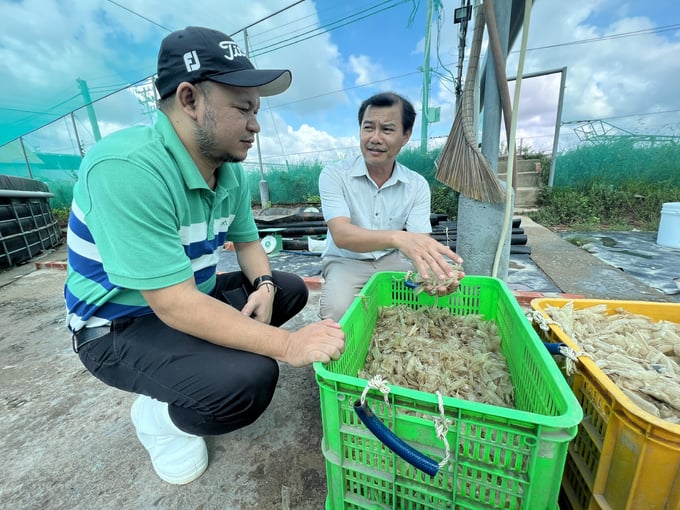
The model for processing shrimp shells into organic matter by Long Nghia Company. Photo: Trong Linh.
The objectives of the sustainable rural agricultural development strategy from 2021 to 2030, with a vision towards 2050, also emphasize the construction of a modern commodity agricultural sector. The Ministry of Agriculture and Rural Development (MARD) is currently in the process of joining the "Emirates Declaration on Sustainable Agriculture, Resilient Food Systems, and Climate Action," which is expected to be adopted at COP28 in December 2023.
Accordingly, the transformation of Vietnam's food system as well as the shrimp value chain is moving towards sustainability, low carbon emissions, adaptability to climate change, and integration of multiple values with a transparent modern management system in association with the digital transformation process. The close collaboration among various stakeholders in the value chain is essential in implementing the national agricultural strategy, action plans, and international commitments in agriculture and rural development.
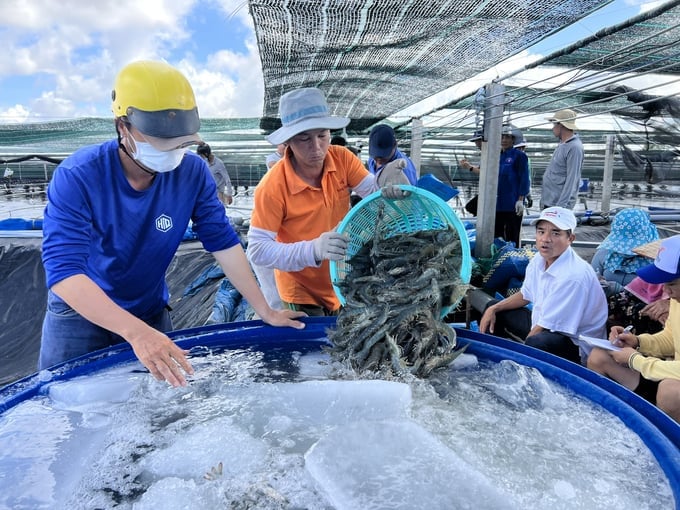
Compared to other countries around the world, the cost of shrimp production in Vietnam is relatively high. Photo: Trong Linh.
According to Mr. Le Tuan Minh, Deputy Director of the Agency of Foreign Trade under the Ministry of Industry and Trade, Vietnam's shrimp export turnover recorded a peak of 4.3 billion USD in 2022, which marks an increase of 11% compared to the same period in 2021. Subsequently, Vietnam became one of the seven largest shrimp exporters in the world. The value of Vietnamese shrimp exports has been trending upward within the last few years, accounting for approximately 40% of the total value of the country's seafood exports.
According to Mr. Minh, the United States is currently the largest consumer market for Vietnamese shrimp, accounting for 23% of the total export value. The U.S. currently imports shrimp from four main suppliers: India, Ecuador, Indonesia, and Vietnam, with the three primary product groups being frozen shrimp meat, frozen shrimp shells, and processed shrimp. Vietnam has a competitive advantage in processed shrimp products. During the first eight months of 2023, the U.S. imported 451 million USD worth of shrimp from Vietnam, which marks a decrease of 27% compared to the same period in 2022.

Mr. Le Tuan Minh, Deputy Director of the Agency of Foreign Trade under the Ministry of Industry and Trade, sharing insights into the export market direction for Vietnamese shrimp products. Photo: Trong Linh.
Furthermore, China has significantly increased its shrimp imports beginning in the second half of 2022. China is also the second-largest shrimp consumption market for Vietnam, accounting for 18% of the total export value. China's main imports include whiteleg shrimp (54.9%), vannamei shrimp (25.3%), and other shrimp varieties. Notably, China is the largest consumer of Vietnamese lobsters. China imported 393 million USD worth of shrimp from Vietnam in the first eight months of 2023, which marks a decrease of 5% compared to the same period in 2022.
In addition, Southern European countries remain the largest consumers of whiteleg shrimp. Following a decline between 2018 and 2020, both Vietnam and India have increased their shrimp exports to the EU. The EU imported 277 million USD worth of shrimp from Vietnam in the first eight months of 2023, which marks a decrease of 47% compared to the same period in 2022.
Regarding the international shrimp trade landscape, Vietnam's shrimp products have remained competitive thanks to its growing processing capabilities. This has allowed Vietnam to produce high-value export products with favorable cost structures, overcoming constraints related to production and transportation costs. Consequently, Vietnamese shrimp has gradually asserted its position within various major markets such as Japan, South Korea, Australia, the United States, the EU, etc. Import demands in many major markets have shown positive signs, and domestic production remains steady.

The export value of Vietnamese shrimp reached 6.67 billion USD in the first nine months of 2023. Photo: Trong Linh.
According to Mr. Minh, the current challenges facing Vietnam's shrimp farming industry encompass fragmented and spontaneous operations, a low success rate in shrimp farming, and high production costs. Low-quality shrimp seeds are also prevalent. Climate change and rising sea levels pose risks to coastal shrimp farming areas, and El Nino affects the shrimp's overall growth and development.
As Vietnam approaches the peak export period for shrimp in late 2023, the global market demand may experience unpredictable fluctuations due to inflation and price competition with other exporting countries. An appropriate direction in alignment with the Strategy for Vietnam's Fisheries Development until 2030, with a vision towards 2045, has been approved by the Prime Minister under Decision No. 339/QD-TTg dated March 11, 2021.
Firstly, Bac Lieu province will focus on its strengths within the shrimp sector including: selecting major shrimp breeding targets to meet seed demand, efficient production organization along the value chain, and the establishment of seafood product branding.
Secondly, the province will emphasize improvement efforts, production support, the application of science and technology, and suitable measures to gradually enhance value and quality, thereby affirming the brand of local shrimp products in both the domestic and international market.
Translated by Nguyen Hai Long
![Reducing emissions from rice fields: [2] Farmers’ commitment to the soil](https://t.ex-cdn.com/nongnghiepmoitruong.vn/608w/files/news/2025/05/05/dsc08881jpg-nongnghiep-140632.jpg)
(VAN) Clean rice cultivation model in Thuong Tan commune, Bac Tan Uyen district, is assisting local residents in achieving sustainable agriculture by substantially reducing costs, increasing productivity, and protecting the environment.

(VAN) At the conference to disseminate Resolution No. 68, AgriS introduced its digital agricultural ecosystem and reaffirmed its commitment to accompanying the Government in promoting private sector development and sustainable agriculture.

(VAN) 'Blue Ocean - Blue Foods' initiative is designed to restore marine ecosystems and establish sustainable livelihoods for local communities by cultivating a minimum of 1,000 hectares of cottonii seaweed in the first three years.
/2025/05/21/4642-3-112707_603.jpg)
(VAN) The V-SCOPE project has made direct contributions to three out of six pillars of the Comprehensive Strategic Partnership between Vietnam and Australia.

(VAN) Facing the threat of rabies spreading to the community, Gia Lai province urgently carries out measures to vaccinate dogs and cats on a large scale.

(VAN) Disease-free livestock farming not only protects livestock herds but also stabilizes production and livelihoods for many farmers in Tuyen Quang.

(VAN) Japan's grant aid project contributes to capacity building, promoting organic agricultural production, and fostering sustainable community development in Dong Thap province.